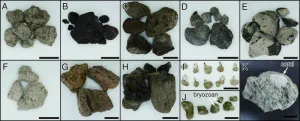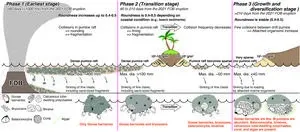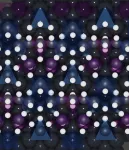Scientists track evolution of pumice rafts after 2021 underwater eruption in Japan
Insights to inform disaster response after future eruption events
2025-02-22
(Press-News.org)
Tokyo, Japan – Researchers from Tokyo Metropolitan University have carried out an unprecedentedly detailed survey of pumice rafts in the aftermath of the 2021 Fukutoku-Oka-no-Ba volcanic eruption in Japan. Using samples from 213 different locations, they considered raft density, the size and roundness of individual pumice, and biological species attached. Their findings revealed three phases in the evolution of drift pumice, involving rounding, fragmentation, and the diversification of attached biological organisms over time.
It is said that 85% of volcanic eruptions happen underwater. While their cousins on land might seem more vivid, the effects of underwater eruptions can be just as devastating: think shockwaves and tsunamis. In 2021, a volcanic eruption under the sea in Fukutoku-Oka-no-Ba in Japan caused mass disruption to ports, ships, and fisheries through the vast amounts of pumice that was produced, creating enormous “pumice rafts” which floated over the sea and deposited on land. Massive pumice raft events like this may be relatively rare, occurring once every ten years or so, but when they do, they can have a devastating effect on everyday lives and livelihoods. Understanding how pumice and pumice rafts evolve as they come over the sea is an important mission for scientists as they try to understand the risks and mitigate their impact on shoreline communities.
A team led by Assistant Professor Daisuke Ishimura have undertaken an unprecedentedly detailed survey of drift pumice from this event, sampled over a year from 213 different shoreline locations in Japan, Thailand, and the Philippines. Since the eruption happened close to an archipelago, it was possible to extensively sample pumice which had washed up over the many islands over time. They focused on the amount of deposit per area, the roundness of individual pumice, and the biological species which were found attached. Drift pumice is also known for its ability to transport species over vast distances; the researchers’ data shed a rare light on when and how this can occur.
The team found that the rafts evolved over three different phases. In the first sixty days or so, pumice rafts are densely packed, leading to lots of collisions between individual pumice as they float on the sea surface. Sharp edges are shaved off, and the pumice is rapidly rounded, as shown directly from the changes in roundness for samples taken after the event. The collisions also make it harder for organisms to attach to the pumice; only goose barnacles are found attached at this stage. After this first phase, pumice continue to fragment and the maximum size of pumice in the rafts decreases, along with the density of the raft as smaller pumice sink. However, newly fragmented pumice clearly tends to round quickly, as the roundness of the pumice remains constant. Bryozoans (simple aquatic invertebrates) join the goose barnacles, but the biodiversity remains relatively low. It is only in the third phase, after 210 days or so, that the biodiversity explodes. The density of pumice on the sea is now low enough that collisions are far less frequent, giving organisms like bivalves and coral a chance to make a home for themselves. This is around the time that rafts are no longer formed.
While individual aspects, like pumice becoming round on the sea, have been noted before, this is the first time that time lapse evidence has been used to put such processes on solid ground. The team hopes their findings inform disaster mitigation efforts in the aftermath of future events.
This work was supported by JSPS KAKENHI Grant Numbers JP21H00631, JP24K00173, JP22J14775, and JP22KJ2555, and a Sasakawa Scientific Research Grant from the Japan Science Society.
END
[Attachments] See images for this press release:


ELSE PRESS RELEASES FROM THIS DATE:
2025-02-21
Historically, access to geothermal energy has hinged on real estate’s famously three most important factors: location, location, and location. Because conventional geothermal power plants require hot, permeable rocks and plenty of underground fluid, use of the technology has been limited mostly to places with recent volcanism, such as Japan, New Zealand, the Philippines, Kenya, El Salvador, Iceland, and the western United States.
Over the past 50 years, however, techniques originally developed for oilfields and adapted for “enhanced geothermal systems” (EGS) have offered the promise ...
2025-02-21
Many Medicare patients with advanced cancer receive potentially aggressive treatment at the expense of supportive care, according to a study that analyzed Medicare records.
The study, published in JAMA Health Forum, examined the quality of end-of-life care among 33,744 Medicare decedents. The study involved patients of diverse ethnic backgrounds, age 66 or older who died from breast, prostate, pancreatic or lung cancers.
Overall, claims records showed that 45% of the patients experienced potentially ...
2025-02-21
As traditional candles burn, they can contribute to indoor air pollution by emitting volatile compounds and smoke, which may pose inhalation risks. Scented wax melts are often marketed as safer alternatives to candles because they’re flame- and smoke-free. But in a study in ACS’ Environmental Science & Technology Letters, researchers describe how aroma compounds released from the melted wax can react with ozone in indoor air to form potentially toxic particles.
Previous research has shown that scented wax melts emit more airborne scent compounds than traditional candles. The ...
2025-02-21
ITHACA, N.Y. –Using underwater microphones and machine learning (ML), Cornell University researchers have developed a new method to estimate North Atlantic right whale numbers — offering a potentially safer and more cost-effective way to monitor this critically endangered species.
Their study, published in Endangered Species Research, demonstrates how microphones combined with ML and traditional aerial survey methods can help track right whale populations in Cape Cod Bay, a crucial feeding ground where the whales gather each spring.
To track this endangered species, researchers rely on costly and dangerous ...
2025-02-21
For nearly two decades, scientists have tried to understand how negatively polarized platinum electrodes corrode, a costly mystery that plagues water electrolyzers, a promising energy technology for making hydrogen, as well as electrochemical sensors using platinum electrodes.
Now, a close collaboration between researchers at the Department of Energy’s SLAC National Accelerator Laboratory and the Leiden University has finally identified the culprit, potentially paving the way for cheaper hydrogen energy production and more reliable electrochemical sensors. The results were published in Nature Materials.
Electrolyzers ...
2025-02-21
Agricultural fertilizers are critical for feeding the world’s population, restoring soil fertility and sustaining crops. Excessive and inefficient use of those resources can present an environmental threat, contaminating waterways and generating greenhouse gases such as nitrous oxide. Now, researchers reporting in ACS Agricultural Science & Technology have addressed those challenges with glass fertilizer beads. The beads control nutrient release, and the researchers say they’re environmentally compatible.
“The results show that glass fertilizers can be tailored to plant needs, slowly and sustainably releasing ...
2025-02-21
Researchers at Stockholm University have developed a fully biobased hair conditioner using lignin gel emulsions, offering a sustainable and environmentally friendly alternative to conventional haircare products.
Hair conditioners typically contain 20–30 ingredients, many derived from petroleum and oleochemicals, raising concerns about sustainability and environmental impact. A new study published in Science Advances, demonstrates that micellar lignin gels can effectively stabilize emulsions with natural oils, reducing the need for synthetic surfactants and complex stabilizers commonly used in commercial formulations. The research team, led by Mika Sipponen at Stockholm University, ...
2025-02-21
Perovskite solar cells are highly efficient and low cost in production. However, they still lack stability over the decades under real weather conditions. An international research collaboration led by Prof. Antonio Abate has now published a perspective on this topic in the journal Nature Reviews Materials. They explored the effects of multiple thermal cycles on microstructures and interactions between different layers of perovskite solar cells. They conclude that thermal stress is the decisive factor in the degradation of metal-halide perovskites. Based on this, they derive the most promising strategies to increase the long-term stability of perovskite solar cells.
Perovskites ...
2025-02-21
University of Houston professors Birol Dindoruk, Megan Robertson and Francisco Robles Hernandez have joined the prestigious list of Senior Members of the National Academy of Inventors.
The University of Houston now has 39 faculty members in the NAI.
“We congratulate these three esteemed colleagues on being named NAI Senior Members,” said Ramanan Krishnamoorti, vice president for energy and innovation at UH. “This recognition is a testament to their dedication, research excellence and pursuit of real-world impact by knowledge and technologies. Their achievements continue to elevate the University as a leader in innovation and entrepreneurship.”
NAI Senior Members ...
2025-02-21
Only two blue whale births have ever been recorded in human history, both decades ago. This remains an extraordinary mystery given there used to be hundreds of thousands of blue whales before whaling started — even today blue whales number around 10,000 to 25,000 — and they give birth every two to three years.
Not only are births very stealthy, but calves are also only rarely sighted — far less than would be expected from their pregnancy rates. Calves closely follow their moms and are sighted as mother-calf pairs, but why are so few detected?
A new University ...
LAST 30 PRESS RELEASES:
[Press-News.org] Scientists track evolution of pumice rafts after 2021 underwater eruption in Japan
Insights to inform disaster response after future eruption events








